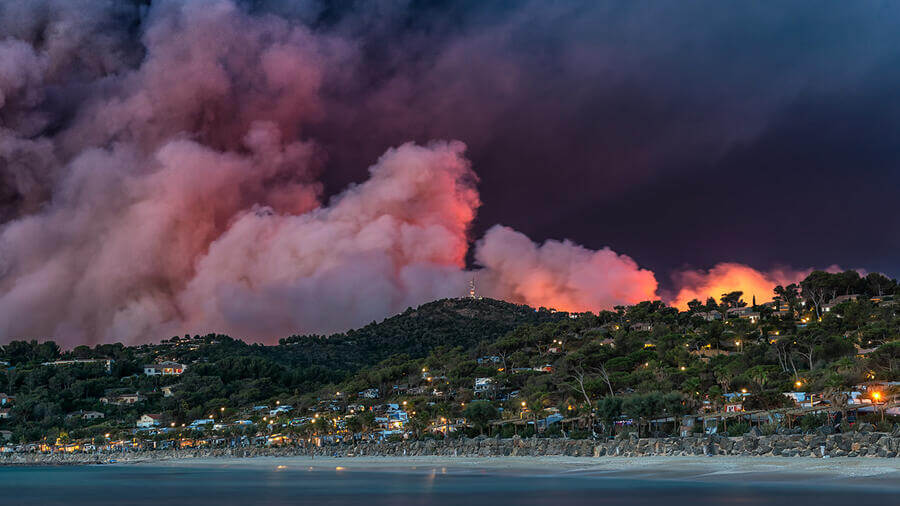Mandy Langfield investigates the landscape between government requirements and the use of private contractors
As fire seasons increase in severity, governments must rely less on contractors and more on serious investment in their own national aerial firefighting resources, according to the experts. Eder Navacerrada, an independent aerial firefighting consultant, flies in Spain, France and Chile, and in the past has worked in Portugal and Sweden. For him, contracts range from three to four months in the shortest cases, to all year around for the longest. “They include a minimum number of days available and a guaranteed number of hours; they are not on a call-as-needed basis,” he explained.
Navacerrada believes governments around the world are investing more in their own sovereign firefighting fleets, as fire seasons lengthen and become more severe. “A great example is Sweden,” he said. “As fires increased in number and severity last decade, we implemented the operation of four amphibious scoopers which, when combined with light helicopters, allow them to respond to initial attacks more effectively. In the past, Sweden proved to be dependent on EU assets, but now it goes both ways, in an interdependent manner.”
It’s an area requiring more attention from authorities. “We have a variety of non-specific assets, and although all this repurposing, breaking and blending may keep our toolbox full and some are worthwhile ideas and fun to fly, I doubt it’s the most effective way to tackle an issue of such magnitude – especially when it comes to production and training,” Navacerrada continued. “Even if current manufacturers add more production lines to meet demand, we would be unable to keep up from a safety standpoint. It is impossible to sustain sales growth without adequate operational/training resources and well-established common standards.
“To be safe and effective, a pilot needs the right background, specific training and three to five years of mentoring. In recent years, mentor pilots have become less prevalent than novel ones. Unfortunately, there have already been accidents where novel pilots were on their own too soon, while experienced pilots attended new contracts.”
Response Down Under
Australia’s plan to invest in a sovereign aerial firefighting fleet was announced following the catastrophic 2019/2020 Black Summer bushfires. Following an investigation into resource management, an annual AU$4 million boost to the National Aerial Firefighting Centre (NAFC) was granted. This would allow for investment in a very large airtanker, to be deployed as needed to different states.
Then Minister for Emergency Management, Senator the Hon Bridget McKenzie, commented: “We have acted on the recommendation of the Royal Commission into National Natural Disaster Arrangements Final Report for an aerial firefighting capability to be tasked according to the greatest national need.” In total, the Australian government has increased its annual investment in aerial firefighting to more than $30 million for the NAFC, to ensure additional resources are available to firefighters. “By working together to pool our resources, all jurisdictions can get maximum value for money and ensure that Australians are protected by the best aerial firefighting equipment possible,” McKenzie concluded.
Ongoing improvements in Australia include the December 2022 addition of a Black Hawk helicopter into Victoria – the state now has 50 aircraft ready to respond during the summer 2023 season. The fleet includes two large airtankers: a CH47 Chinook, Super Puma and Air Crane. Despite this, and to support Navacerrada’s assertion that national efforts alone are not sufficient for wildfire threats, Victoria also has a surge capacity of up to 100 aircraft that can supplement the core fleet and be called on contract when needed.

Conair’s global reach
Jeff Berry is Director of Business Development with Conair Aerial Firefighting, one of the companies serving Australia: “[The country] is adapting to the new reality, creating a sovereign fleet that is positioned on the continent year-round on four-year contracts, for 168-day minimum standby per season, using a long-term contract format, sharing resources between states as their fire seasons differ, with one state’s season ending as another starts.
“We manufacture airtankers for government customers around the world. For instance, we have partnered with France since 1984, first providing Firecats and now the multi role Dash 8-400MRE airtanker, which has been in operation for over 17 years. The eighth Dash 8-400 will be delivered this year,” shared Berry. “In addition to making airtankers, we own a diverse fleet of 70 aircraft, providing aerial firefighting services for over 50 years. We work primarily in Canada, US and Australia, but have operated around the world. There are over 90 pilots and 60 aircraft maintenance engineers in our Canadian-based operation alone, to support customers,” he added.
Requirements vary enormously for each country, as Berry explained: “Canada is a very mature market, having fought extreme wildfires for decades, with jurisdictions securing fleets of aerial resources through four-to-10-year contracts which last the entire fire season – usually a minimum of 120 days. The US is also a mature market federally, with individual states now committing to long-term contracts of four years or more, often extending for 90 to 120 days, knowing they can subcontract these fleets to other states when not needed locally.” In the US, the fire season is now referred to as a fire year, so even when a contract ends for one state, opportunity exists in others to go call as needed.
On the dotted line
Contract types are gradually changing, as governments need support for longer from private operators, with extended deals now the norm. While there used to be sufficient time for the North/South Hemisphere swap from summer to winter seasons, this is not the case any more thanks to climate change, with the occasional exception. So, the requirement for ongoing maintenance is increased as there is no operator down time.
“The majority of our fleet is committed on long-term contracts for the full season,” Berry said. “When North America is done, South America and Australia start up. There can be some sharing, provided airtankers receive heavy maintenance in-between contracts. And provided deals are long enough to warrant the additional costs of extra maintenance, crewing, training, plus all the logistics required to bring an airtanker into a new country, introducing a different language, different operational procedures and permitting. Responding across the globe for a week-long mission at the last minute isn’t very financially viable, even if we have crews and the aircraft maintenance is complete.”
Berry agreed with Navacerrada that there is a general trend towards more government control, while still needing support from private contractors: “Some agencies are investing in their own fleets, proactively securing resources to have them on hand when needed – Canada, some US states, Australia, France. Other markets new to extreme wildfires are learning, realizing they have a challenge: how they used to do things isn’t working, so they’re researching solutions,” he said.
But change takes time and doesn’t happen overnight: “We regularly receive requests for proposals for airtankers with less than a month’s notice to deployment,” Berry pointed out. And in further concordance with Navacerrada, it’s not just the aircraft themselves that need to be in the right place at the right time – crews are also essential: “Aerial assets are very likely not available with this limited notice, as they are either in use or in heavy maintenance, or not crewed with appropriately trained pilots,” Berry said. “Airtankers are not sitting idle anywhere in the world – they are all in use. If an agency wants to order their own airtanker for their own fleet, it will take a year to deliver, given current scheduling – in the case of the Dash 8-400AT – or years for other large airtankers, not including crew training and operational incorporation. If you look at the weather forecast for tomorrow and think you need to add aerial resource support, you are too late.”

Market capacity of firefighting assets
On the topic of whether there is sufficient capacity to respond to the increasing needs of governments around the world regarding aerial firefighting assets, Navacerrada is emphatic: “I don’t think so. Despite operators covering government-specific areas of the world quite effectively, from a global perspective we are unable to keep up.
“Forest fires have finally been addressed from both an environmental standpoint and homeland security perspective, and as a result we should see more investment, types and operators during this decade. However, we are still years away from a specific design that can be produced at the speed the market demands. Current solutions take a long time from ordering until front line availability.”
Berry agreed: “There isn’t enough capacity if we are getting requests at the peak of fire season for airtankers on a moment’s notice from across the world. The climate is changing. The number of volatile, extreme wildfires is increasing. All you can do in these instances is hammer the fire on initial attack with everything you’ve got available, hoping to keep up with Mother Nature so firefighters on the ground can contain it. Calling in airtankers from other countries after the fire takes hold means you are in it for the long haul and facing catastrophic outcomes. Aerial assets need to be ready and in relatively close position, with clear training and operational direction in place before a fire starts.”
Issue of predictability
A problem for governments that may not have experienced a significant fire event is the justification for spending tens of millions of dollars on assets that aren’t used for years. But they’ll still have to pay for maintenance, storage and staff training. However, being unprepared for a fire season can lead to a lot of public criticism. And if you wait until the last minute to secure resources, you’re inevitably going to end up paying more for them – like Uber for aerial firefighting.
Berry said: “Aerial firefighting is a bit like farming. You might have three slow years to two busy years, but you must secure contracts that cover the downtime as developing, building, maintaining and operating specialized aircraft and crews is very costly – as is investing in equipment upgrades. Without long-term contracts, it would be very difficult for organizations to invest in next-generation fleets, which Conair just did when we retired our legacy CV580 and L188 airtankers, replacing them with modern RJ85 and Dash 8-400s.”
Government agencies need to be able to forecast expenses. Long-term contracts offer the ability to both secure fleets, plus nail down operational costs into the future, ensuring they receive competitive pricing and availability. “It is supply and demand economics,” concluded Berry. “If you demand when supply is low, last minute, you will pay more, if you can even find the inventory.”
Mandy Langfield
Mandy is the Editor of AirMed&Rescue. She’s worked in publishing for over a decade, and was previously Assistant Editor of the magazine before taking over as Editor in December 2017. Her favourite helicopter is the Chinook, having grown up near an RAF training ground!
SOURCE: https://www.airmedandrescue.com/latest/long-read/government-requirements-and-use-private-contractors-aerial-firefighting

